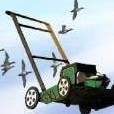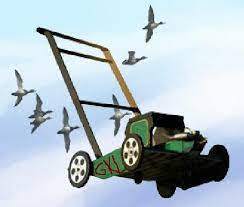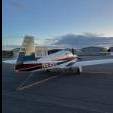-
Posts
2,463 -
Joined
-
Last visited
-
Days Won
2
Jim Peace last won the day on May 14 2018
Jim Peace had the most liked content!
Profile Information
-
Gender
Male
-
Location
7FL6, Spruce Creek FL, Heaven on Earth
-
Model
64 M20C
Jim Peace's Achievements
-

Starlink Question that needs another thread I think
Jim Peace replied to cliffy's topic in Miscellaneous Aviation Talk
I was commenting on that picture posted above....it's appears to be a front window..... -

Starlink Question that needs another thread I think
Jim Peace replied to cliffy's topic in Miscellaneous Aviation Talk
Blocking the window is such a great idea....awesome brainpower there..... -
On October 31, 2025, about 1035 eastern daylight time, a Mooney M20E, N79338, was destroyed when it was involved in an accident near Ballston Spa, New York. The pilot was fatally injured, and the flight instructor was seriously injured. According to the flight instructor, the pilot had just purchased the airplane and he was going to fly with the pilot to Punta Gorda, Florida, where the pilot lived. The insurance company required the pilot to fly with a flight instructor due to the pilot’s lack of experience in the airplane make and model. The flight instructor stated that he met the pilot for the first time the night before the accident, and they discussed the airplane’s maintenance issues and planned flight route. The flight instructor added that the pilot had test flown the airplane about 1 month prior to the accident flight. He also stated that the airplane’s engine lost power during the pilot’s test flight and that he had landed safely back at the airport at he end of that flight. The flight instructor described that the airplane’s fuel had been contaminated with algae and debris. A local mechanic subsequently repaired the fuel tank and cleaned out the fuel system. On the day of the accident flight, the flight instructor and pilot performed a preflight inspection of the airplane and sampled fuel from the fuel tanks several times before departing. The flight instructor stated that after takeoff and during the initial climb, about 200 ft above ground level, the engine decreased in power from 2,500 rpm to about 1,500 rpm. A few seconds later the engine decreased to about 500 rpm and then lost all power. The flight instructor took over control of the airplane and tried to make a turn back to the airport. When he made a right turn, he realized that the airplane was too low. He then made a slight left turn to avoid a house before the airplane impacted a tree. The accident site was located in a subdivision beside a house. The airplane impacted a tree about 20 ft up, fell to the ground, and came to rest oriented on heading of 232° magnetic. The engine was fractured off its mounts and lying beside the fuselage. The propeller was still attached to the engine and did not display s-bending, leading edge gouging, or chordwise scratching. All major components of the airplane were located at the accident site. A postimpact fire consumed portions of the engine, instrument panel and cockpit. No useful information was obtained from the remaining instrumentation. The right wing root was still attached to the fuselage and about 6 ft of the outboard portion of the wing was located in a tree directly above the main wreckage. The aileron was still attached to the outboard portion of the wing. The right flap remained attached to the wing. The flaps were in the full retracted position. The left wing also remained attached to the fuselage. The wing was consumed by fire, and the left fuel tank was destroyed. The flap was attached to the wing. About 3 ft of the outboard portion of the left wing fractured off the wing and was located about 20 ft from the main wreckage. The left wing had several tree impressions down the leading edge. The cockpit, instrument panel, and engine bay were destroyed by fire. No useful information was obtained. The tail section was attached to the empennage. The left stabilator and elevator were bent up mid-span. The rudder and right elevator were unremarkable. The airplane was further examined after it was recovered from the accident site. Flight control continuity was visually established through torque tubes and fracture surfaces consistent with impact damage. The fuel system from the pickup tubes to the engine fuel injectors was clear of debris and air was passed through all lines and valves. The system exhibited no blockages or other abnormalities. The engine rocker box covers, engine driven fuel pump, magnetos, and the remnants of the airframe baffling were removed. The crankshaft was rotated by applying hand pressure to the propeller, and after the start ring gear and propeller collar were removed, full 360° rotation of the crankshaft was achieved. Compression and suction were observed on all four cylinders, normal valve action was observed on all cylinders, the accessory idler gears were observed rotating, and mechanical continuity was confirmed throughout. The cylinders were examined with a boroscope. Oil pooling was observed in the No. 2 and No. 4 cylinders, and all cylinders were clean with very little deposits on the piston faces or combustion domes. The induction plenum was inspected via borescope and no blockage or obstructions were observed. All four induction tubes remained attached to the engine with various levels of impact-related damage. The exhaust system remained secure to the engine and was partially crushed from impact forces. It was inspected via borescope and no blockage was observed. The fuel flow divider remained secure to the crankcase spine. All four fuel injection lines remained secure to the flow divider, and to their respective fuel injection nozzles. The fuel inlet line remained secure to the flow divider. The flow divider and lines were removed and the flow divider was disassembled. The diaphragm was brittle and destroyed consistent with exposure to extreme heat, and no blockage was observed in the flow divider. Air was blown through the inlet fitting and was observed coming out of all four injection nozzle lines. All four fuel injection nozzles were removed and oil was present in the No. 2 and No. 4 nozzles (oil likely from the orientation of the engine after the accident). The oil was blown out and no contamination was observed in any of the fuel injection nozzles. All four of the nozzles had the restrictor inserts installed. Air was blown through the flow divider inlet fuel line and fuel flow transducer, no obstructions observed. The engine-driven fuel pump remained attached to the engine accessory housing with the fuel inlet and outlines secure to it. The fuel inlet line had been cut during the engine recovery process. The engine driven pump was removed; it did not create inlet suction and outlet pressure when the lever was actuated. The pump was disassembled, the diaphragms were brittle and destroyed consistent with exposure to extreme heat. The fuel pump was filled with engine oil. The left and right magnetos remained secure to the engine accessory housing with the harness caps secure to the magnetos. The magnetos were removed and both drives were found secure via castle nut and cotter pin. The left magneto’s drive was not free to not rotate. While the right magneto’s drive rotated, no spark was observed. Both of the magnetos displayed thermal damage consistent with exposure to the postimpact fire. About 6 gallons of fuel was removed from the right wing fuel tank. The fuel was blue in color and smelled like 100LL fuel. No water or debris was found in the right fuel tank. The left fuel tank was consumed by fire.
-

Sensorcon battery life - informal test over 6 months
Jim Peace replied to Bolter's topic in Miscellaneous Aviation Talk
I just found this thread....I have two of them and sometimes forget to turn them off and weeks would go by before I got back to the plane. They still work and are many years old. -
There may be a pill or a procedure for that...
-

Rght out of the gate? Seriously???
Jim Peace replied to Freddb34's topic in Vintage Mooneys (pre-J models)
I just have my girlfriend do it for me.....it's her JOB.... -

CO2 detectors the "Good The Bad and The Ugly
Jim Peace replied to Jpravi8tor's topic in Vintage Mooneys (pre-J models)
I do not want it mandated. I want pilots to do the right thing and get these portable CO detectors on their own but most will not due to the 100 dollar cost to save their life and their passengers. I remember when I installed a 406 ELT years ago. I actually got some backlash from pilots telling me it was crazy to do that being that it was "not required." I think it was 600 dollars at the time to give me the ability to be found on a map in minutes vs hours or never..... -

CO2 detectors the "Good The Bad and The Ugly
Jim Peace replied to Jpravi8tor's topic in Vintage Mooneys (pre-J models)
what would you say the percentage of GA piston planes flying today have a great CO detector with live readings displayed in your face? I am not talking about that scratch and sniff POS.... -

CO2 detectors the "Good The Bad and The Ugly
Jim Peace replied to Jpravi8tor's topic in Vintage Mooneys (pre-J models)
I fly with two. One to check the checker. On the ground they are reading sometimes double digits. I taxi with the door open almost 100% of the time. In the air they read 0. Maybe low single digits with the heat on or if the cowl flaps are open it may read between 1-3ppm. Every plane should have these. They are cheap and do save lives. I read nearly 200ppm one day and found some scat tubing off in the cowling. Unfortunately we will need legislation to mandate expensive panel mounts due to cheap ass pilots who refuse to smarten up. -

Rght out of the gate? Seriously???
Jim Peace replied to Freddb34's topic in Vintage Mooneys (pre-J models)
yes...on the ground it should only be on when aircraft is moving and not in another pilots face......but in the air it should basically stay on 100% of the time below 18,000.. -

Rght out of the gate? Seriously???
Jim Peace replied to Freddb34's topic in Vintage Mooneys (pre-J models)
This has nothing to do with your issue but why would you turn off the landing light? see and be seen.....should stay on 100% of the time you are below 18,000 feet... -
Or MDOC....whatever happend to him?
-
did you have carb heat on? I like your 0 FF,,did you have your CARB heat on? Here is mine the other day at either 8 or 9000 feet...
-
I know EGT's really don't have a red line but in the O-360 in a C what would be highest number you would want to see even if CHTs are at or under 400?









